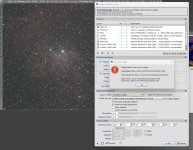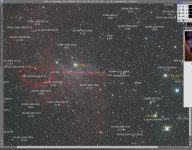A new set of asteroid ephemerides files in XEPH format is now available on our distribution server. The new files cover the time span from 2019-12-02 to 2023-01-01 and include the first 500,000 numbered asteroids. These XEPH files can be used to compute high-precision ephemerides with our solar system ephemerides engine, as well as to generate asteroid annotations for plate-solved images with our standard AnnotateImage script.
The new XEPH files provide Chebyshev polynomial expansions for position in barycentric rectangular coordinates coherent with fundamental JPL DE440 ephemerides (ICRS), with maximum truncation errors below 1e–10 au (about 15 meters) for the vast majority of objects in the main asteroid belt, and proportionally smaller errors for objects closer to the Sun.
These XEPH files have been generated by numerical integration of perturbed orbital motion with our standard EphemerisGenerator process. Initial conditions have been obtained from the Asteroid Orbital Elements Database by Lowell Observatory, latest astorb.dat file for epoch 2022-01-21. The implemented physical model includes:
The whole numerical integration to generate these 10 XEPH files (826 MiB) has required about 75 hours on a dedicated workstation with an AMD Ryzen 9 5950X 16-core processor and 128 GiB of RAM running Kubuntu 20.04 Linux.
The new XEPH files provide Chebyshev polynomial expansions for position in barycentric rectangular coordinates coherent with fundamental JPL DE440 ephemerides (ICRS), with maximum truncation errors below 1e–10 au (about 15 meters) for the vast majority of objects in the main asteroid belt, and proportionally smaller errors for objects closer to the Sun.
These XEPH files have been generated by numerical integration of perturbed orbital motion with our standard EphemerisGenerator process. Initial conditions have been obtained from the Asteroid Orbital Elements Database by Lowell Observatory, latest astorb.dat file for epoch 2022-01-21. The implemented physical model includes:
- Perturbations from Mercury, Venus, Earth, Moon, Mars, Jupiter, Saturn, Uranus, Neptune and Pluto. State vectors and constants are provided by XEPH fundamental ephemerides (currently JPL's DE440).
- Perturbations from the 343 most massive asteroids used in DE430 and DE440 numerical integrations. State vectors and constants are provided by XEPH asteroid ephemerides (currently DE430 asteroid ephemerides consistent with DE440).
- Perturbations from the 30 most massive Kuiper belt objects (KBOs). State vectors and constants are provided by XEPH ephemerides generated with this same implementation, starting from DE440 initial state vectors.
- Relativistic perturbation terms (DE440's PPN model) up to O(1/c^2) for the point-mass accelerations induced by all planets, Moon, Pluto and the five most massive asteroids.
- Direct acceleration perturbation terms caused by oblateness. Zonal harmonics J2 are computed for Sun, Earth, Mars, Jupiter, Saturn, Uranus and Neptune.
The whole numerical integration to generate these 10 XEPH files (826 MiB) has required about 75 hours on a dedicated workstation with an AMD Ryzen 9 5950X 16-core processor and 128 GiB of RAM running Kubuntu 20.04 Linux.


